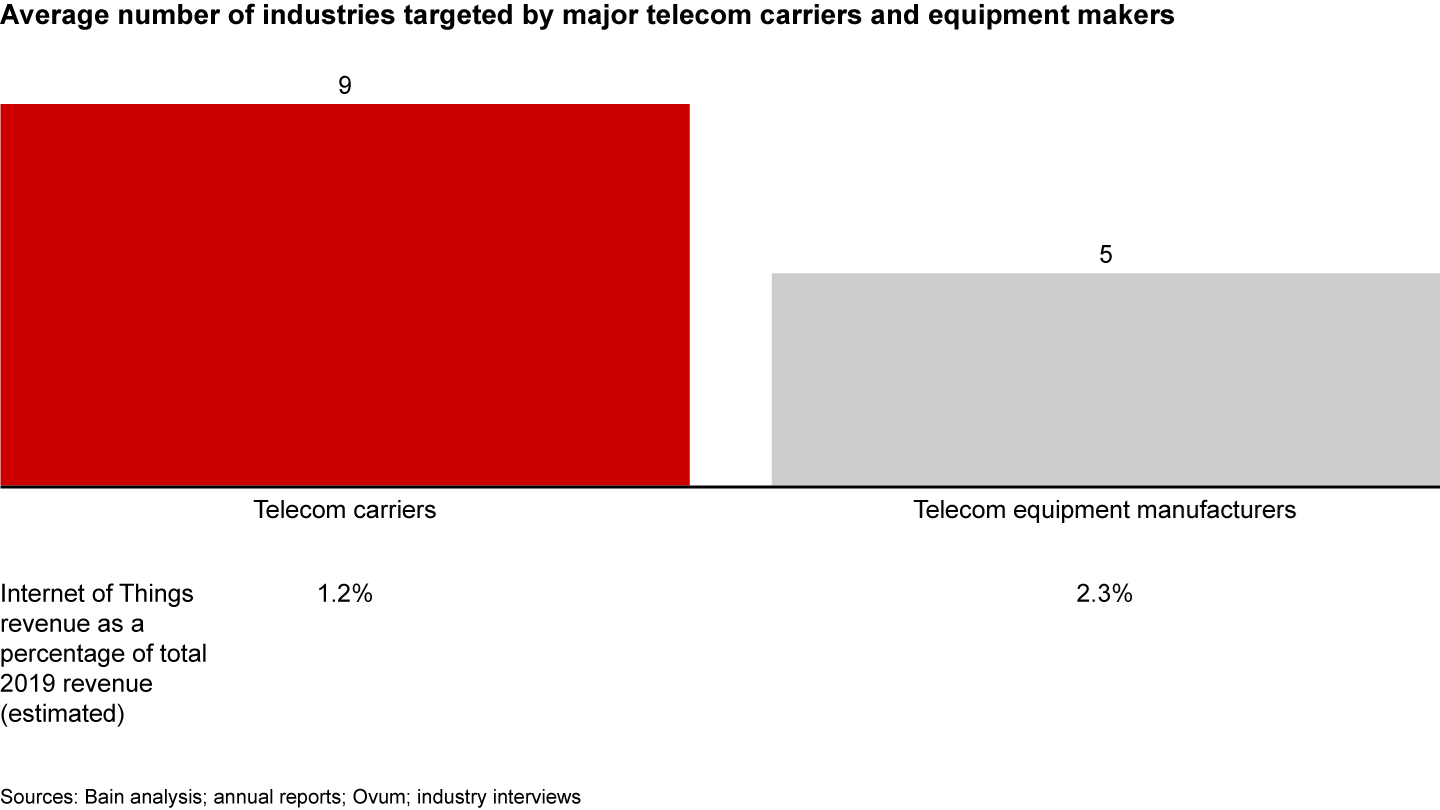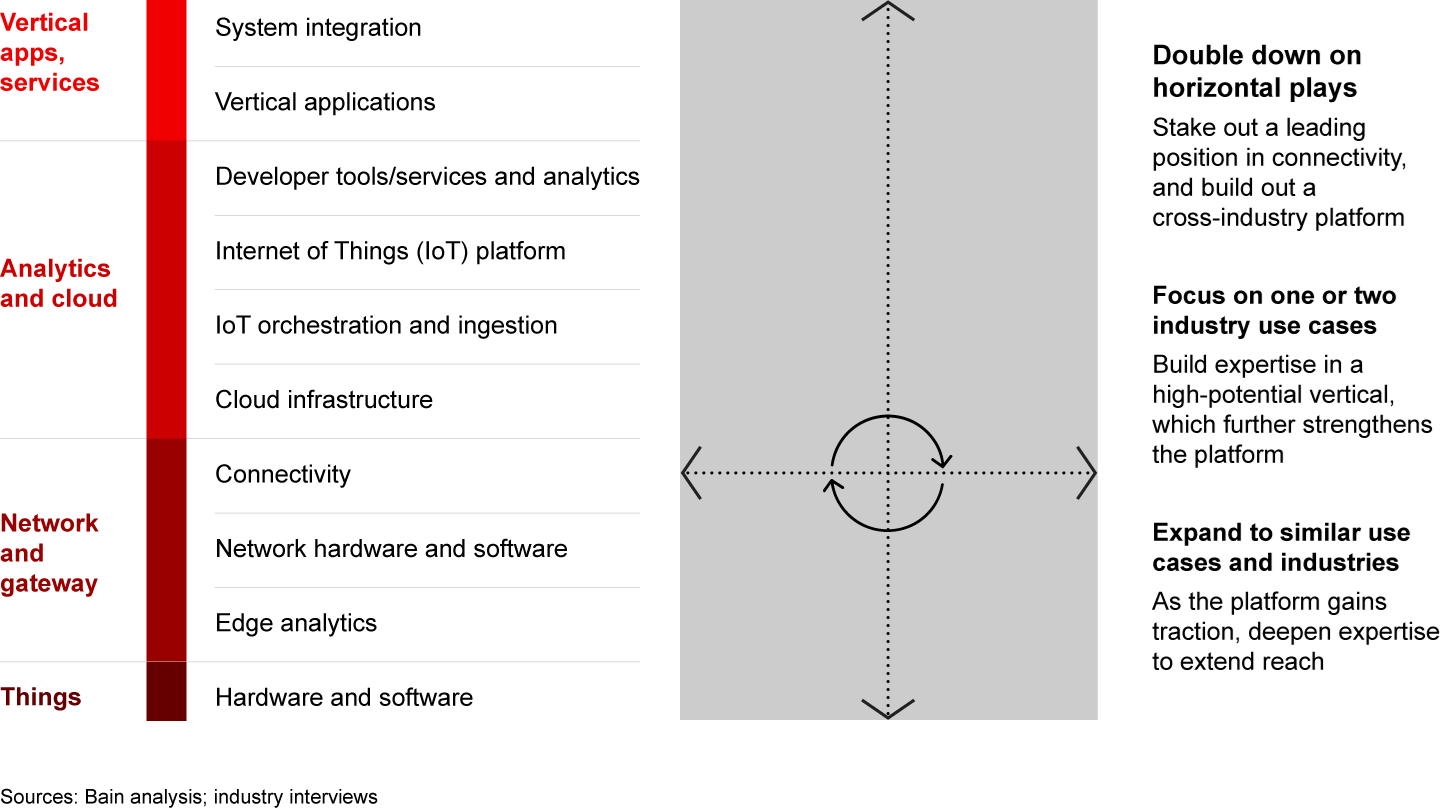Brief

In evidenza
- Connecting the billions of devices that make up the Internet of Things presents an extraordinary opportunity for telecom carriers and equipment makers.
- But telcos have struggled to gain traction because they have targeted too many industries, stretching their credibility.
- A better approach starts with a focus on core capabilities around connectivity, developing a strong cross-industry platform, and extending to one industry use case at a time to build expertise gradually.
One reason why telecom carriers and telecom equipment makers haven’t gained as much traction as they had hoped to in the Internet of Things (IoT) is that they have been unsure about whether to go horizontal or vertical in their approach to the market. For most, traditional strengths lie in their horizontal capabilities—namely, building and selling connectivity solutions that work as well in healthcare and financial institutions as they do in industrials and utilities.
But executives also recognize the opportunity in tailoring IoT solutions to certain industries, and for that, they have often paired up with industry-specific vendors that know the territory (see the Bain Brief “Selling IoT Solutions to Experts”). Among those that have chosen to focus on industry-specific solutions (carriers more than the equipment makers), most have spread themselves too thinly, often trying to master as many as nine industries at once (see Figure 1).
Telcos have tried to focus their Internet of Things efforts on too many industries


The strategy of pursuing industry-specific use cases is attractive because, as telecom executives know, their business customers tend to believe that the challenges of their industries are unique. And the decision makers for purchasing such solutions tend to be operations executives, steeped in the challenges of reliably delivering industry-specific solutions. Indeed, even within cross-industry horizontal connectivity solutions, the last-mile problem of integrating connectivity with a specific company’s or industry’s needs can be most daunting.
But telecom carriers and equipment makers often struggle to prove their industry-specific credibility to IoT buyers that see the IoT solutions providers as the experts in the best position to understand the unique requirements of each customer. By teaming up with these IoT sellers, the telcos increase their chances at bridging the operational credibility as well as any commercial gaps. Even so, spread too thinly across too many industries, the telcos have had difficulty gaining traction at levels that would contribute significantly to their bottom lines.
Toward a virtuous cycle
A winning IoT strategy builds a virtuous cycle of horizontal and vertical gains, starting with successful core capabilities of connectivity and then layering on expertise within industry-specific use cases to build scale and market leadership (see Figure 2).
A winning IoT strategy needs to build a virtuous cycle of horizontal and vertical plays


Double down on horizontal plays. Leaders stake out a winning position in their core market of connectivity, defending their positions with low-power networks and wide area networks that support the IoT (for example, LTE-M and NB-IoT) while continuing to invest in 5G. From there, they can build out cross-industry platforms that take advantage of demand for new connectivity services, including life-cycle management of devices and connections, security, and private networks.
Focus on one or two industry use cases. Going broad can impede progress. Narrowing the focus on a few high-priority needs in connectivity (such as latency sensitivity, reliability, or coverage) in the industries with the greatest potential allows telcos to build expertise and credibility, which in turn strengthens their opportunity to successfully provide a cross-industry platform.
Telcos should also target opportunities in which they can bring their strengths to bear. Utility companies, for example, are accustomed to thinking long term, since they develop capital projects that last for decades. A similarly long-viewed telco could make an ideal partner when deploying smart meters or other connected devices that are expected to last 10 or 15 years—perhaps more suited to the application than a start-up or cloud service provider (CSP) that evolves its offerings rapidly.
Expand to similar use cases and adjacent verticals. As the platform gains traction (and the telco gains credibility within its chosen use cases), expanding to similar applications and related industries becomes a natural move. The constructive combination of horizontal capabilities with vertical expertise triggers a virtuous cycle that can help build scale and marketplace leadership.
The most important message for carriers today is that they no longer have complete control over the deployment of new platforms. Today, this occurs in a much more open model. Adoption of a new platform depends on factors such as the ease of building out industry-specific solutions or the richness of available examples and building blocks. Creating new platforms requires carriers to cultivate relationships with developers and ecosystem partners, something that they have not had to do in the past but that is part of the secret sauce of successful CSPs and born-in-the-cloud solutions.
Carriers that are furthest along in this journey are those that have healthy partnerships with value-added resellers and systems integrators, with open software development kits and application programming interfaces for assembling and tuning communications services to meet enterprise use cases. But we also see that greenfield plays by emerging leaders such as T-Mobile in the US and Jio in India are building upon the lessons of successful cloud and platform providers.
Competitive threats rising
Telecom carriers and equipment makers have wrestled with their approach to IoT services for nearly a decade, but they may be running out of time to capture this market. The large CSPs are expanding into this area and taking advantage of software-defined networks to compete with telcos in their core battleground. Acquisitions in this niche, such as Microsoft’s purchase of Affirmed Networks, have helped CSPs to bring server-like infrastructure into the telcos’ central office in ways that let them run other workloads as well, including the types of IoT services that telcos would like to offer.
The entry of mobile virtual network operators (MVNOs) offering IoT services adds further complication for telcos, both as a competitive threat and as a partnering opportunity. Just as traditional MVNOs have thrived by simplifying the telecom proposition for consumers, a rising wave of MVNOs offering IoT services (some brand new, some entering from established positions) are poised to take market share and claim some portion of the profit pool, whether in concert with or in place of telcos.
In light of these and other pressures, telcos may want to quicken the pace of their efforts, narrow their focus on select niches, and redouble their sales efforts in this area. Some carriers have spent more time and money than they should have on determining the perfect solution. Now is the time to choose a lane and power ahead.